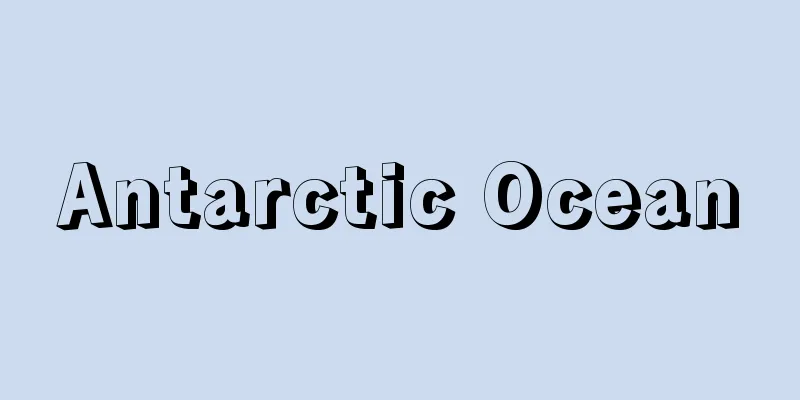Antarctic Ocean

|
The ocean surrounding Antarctica is also called the Southern Ocean or Antarctic Ocean. There is no fixed oceanographic boundary, so for convenience it can be referred to as the ocean south of 55 degrees south latitude to Antarctica, or the ocean south of the Antarctic Convergence. If we use the former definition, the area up to the edge of the ice shelf is about 3.25 million square kilometers, and the average depth is about 3,700 meters. The total area includes the Ross, Filchner, and other ice shelf areas. [Masao Hanzawa and Kenzo Takano] Submarine topographyThe Antarctic Ocean, excluding the coastal areas, is approximately 3,000 to 4,000 meters deep, with the Pacific-Antarctic Basin (divided into southeast and southwest), South Indian Ocean Basin, and Atlantic-Indian Ocean Basin each having a depth of about 5,000 meters. The deepest part is the Meteor Deep, located just east of the South Sandwich Islands, at a depth of 8,200 meters. Antarctica has two large oceans, the Ross Sea on the Pacific side and the Weddell Sea on the Atlantic side, and at the back of the Ross Sea is the Ross Ice Wall, which is 800 kilometers wide and over 30 meters high. [Masao Hanzawa and Kenzo Takano] Sea conditions and currentsAn oceanographic feature of the Southern Ocean is the presence of significant convergence and divergence lines around the Antarctic continent, both of which are accompanied by discontinuities in sea surface temperatures. (1) Antarctic Convergence Also known as the Polar Frontal Zone, it is located at approximately 50 degrees south latitude in the Atlantic and Indian Oceans, and at approximately 60 degrees south latitude in the Pacific Ocean. It is the tidal boundary that separates the Antarctic Ocean from the Sub-Antarctic Ocean. (2) The Antarctic Divergence Line It circles the coast of Antarctica and is found about 1,100 kilometers south of the Antarctic Convergence Line. This location is near the boundary between the westerly winds, which are the prevailing winds in the Southern Hemisphere, and the easterly to northerly winds very close to the continent. (3) Circumpolar Antarctic Current This is a current that flows around the Antarctic Ocean, and its strongest part is near the Antarctic Convergence. Although the flow speed is less than about 1 knot (about 0.5 meters per second), this current is thick and reaches deep layers, so the flow rate is large, and in the Drake Passage, the flow rate is 200 million cubic meters per second, far exceeding the flow rate of the Kuroshio Current and the Gulf Stream. Further south of the Antarctic Divergence, there is an easterly skin current that flows westward, and is most developed in the Weddell Sea, where it collides with the Antarctic Peninsula and forms a clockwise flow. The sea surface temperature south of the Antarctic Convergence is below -1.7°C in winter and around 0°C in summer, and the surface salinity is about 34 psu, but in the melting ice area, it is about 32 psu. The main area where deep water is formed (where it sinks from the surface) is the Weddell Sea, and the water mass structure of the Antarctic Ocean is important in considering the global circulation of seawater. [Masao Hanzawa and Kenzo Takano] Sea iceThe amount of sea ice (ice formed by freezing seawater, different from icebergs) floating in the Antarctic Ocean varies from year to year, but is about 0.03 million cubic kilometers in winter and 0.005 million in summer. Its area is about 20 million square kilometers in winter and 2.5 million in summer. Therefore, the average thickness is 1.5 meters in winter and 2.0 meters in summer, making it thinner in winter. This is because the Antarctic Ocean is wide open to the north, so the ice spreads widely and thinly to the north in winter. Compared to the Antarctic Ocean, the Arctic Ocean is surrounded by land, so sea ice cannot spread widely in winter, and is therefore thicker than in summer. [Masao Hanzawa and Kenzo Takano] icebergAn iceberg is a large block of ice that has fallen from land and is now floating in the ocean. Many of the icebergs in the Antarctic Ocean are huge, table-shaped. Many are up to 200 kilometers long. [Masao Hanzawa and Kenzo Takano] SedimentThe open ocean sediments are mainly diatomaceous ooze, but also contain glacial clay. The bottom sediments of the Antarctic Ocean changed from red clay of about 1.6 million years ago to the present, which is evidence that a gyre around the Antarctic continent has existed continuously from at least 1.6 million years ago to the present. [Masao Hanzawa and Kenzo Takano] "Antarctic Science Museum" edited by the National Institute of Polar Research (1990, Kokon Shoin)" ▽ "The Story of the Earth Told by Antarctica" written by D. G. Campbell and translated by Sasano Yoko (1993, Kodansha)" ▽ "Antarctic Photography: 120,000 km" written by Shirakawa Yoshikazu (1995, Shogakukan)" ▽ "Illustrated Encyclopedia of World Geography 23: Oceania and Antarctica" edited by Tanabe Yutaka (1997, Asakura Shoten)" [References] | | | |Most of the Antarctic sea ice is first-year ice . Antarctic sea ice Tabular icebergs (table-shaped icebergs). They often break off from ice shelves and drift away, and are relatively large. ©Shogakukan "> Antarctic iceberg Source: Shogakukan Encyclopedia Nipponica About Encyclopedia Nipponica Information | Legend |
|
南極大陸を巡る海で、南大洋(なんたいよう)Southern Ocean、南氷洋ともいう。海洋学的に決まった境界はなく、便宜的に南緯55度以南の南極大陸までの海をさすか、南極収束線以南の海をさす。前者の定義による場合、面積は棚氷(たなごおり)縁までで約325万平方キロメートル、平均深度は約3700メートルである。全面積はこれにロス、フィルヒナーなどの棚氷海域が加算される。 [半澤正男・高野健三] 海底地形南極海は沿岸部を除き、おおよそ3000~4000メートルの深度をもち、太平洋・南極海盆(南東、南西に分かれる)、南インド洋海盆、大西洋・インド洋海盆はそれぞれ5000メートルぐらいの深度である。最深部はサウス・サンドイッチ諸島のすぐ東にあるメテオール海淵(かいえん)で、深度8200メートルである。南極大陸には、太平洋側のロス海、大西洋側のウェッデル海と二つの大きな海があり、ロス海内奥には幅800キロメートル、高さ30メートル以上のロス氷壁がある。 [半澤正男・高野健三] 海況・海流南極海の海洋学的特徴は、南極大陸を巡って顕著な収束線と発散線があることで、いずれも海面水温の不連続を伴う。 (1)南極収束線 極前線帯ともいわれ、位置は大西洋とインド洋で南緯50度付近、太平洋で南緯60度付近である。南極海域と亜南極海域を区分する潮境(しおざかい)である。 (2)南極発散線 南極大陸沖をほぼ一周し、南極収束線の約1100キロメートル南にみられる。この位置は南半球の卓越風である西風と、大陸のごく近くの東から北寄りの風の境界付近にあたる。 (3)周南極海流 南極海を一周して流れる海流で、最強部は南極収束線付近にある。流速は約1ノット(秒速約0.5メートル)以下であるが、この海流は深い層にまで厚く及んでいるので流量は大きく、ドレーク海峡では毎秒2億立方メートル、黒潮やガルフストリームの流量をはるかにしのぐ。南極発散線のさらに南では西へ向かう東風皮流があり、ウェッデル海でもっとも発達し、南極半島にぶつかって時計回りの流れを形成する。南極収束線以南の海面水温は冬季は零下1.7℃以下、夏季は0℃前後であり、表面塩分は34psu程度であるが、融氷域では32psu程度になる。深層水のおもな形成域(表層から沈降する所)はウェッデル海であり、南極海の水塊構造は世界の海水の大循環を考えるうえで重要である。 [半澤正男・高野健三] 海氷南極海に浮かぶ海氷(海水が凍ってできた氷で、氷山とは違う)の量は年によって変わるが、100万立方キロメートルを単位として、冬に0.03、夏に0.005くらいである。その面積は、100万平方キロメートルを単位として、冬に20、夏に2.5くらいである。したがって平均の厚さは、冬で1.5メートル、夏で2.0メートルとなり、冬のほうが薄い。南極海は北に広く開いているので、冬には氷が北へ広く薄く延びていくからである。南極海に比べ、まわりを陸に囲まれている北極海では、海氷は冬に広く広がれないので夏よりも厚くなる。 [半澤正男・高野健三] 氷山陸上の大きな氷塊が海に落ちて浮かんでいるのが氷山である。南極海の氷山は巨大な卓状のものが多い。長さ200キロメートルに及ぶものが少なくない。 [半澤正男・高野健三] 底質外洋性堆積(たいせき)物は主として珪藻(けいそう)軟泥であるが、氷河性の粘土も含まれている。南極海の底質は約160万年前の赤粘土性のものから現在のものに変わっており、これは、南極大陸を巡る環流系が少なくとも160万年前から現在まで継続して存在していることの証(あかし)といえよう。 [半澤正男・高野健三] 『国立極地研究所編『南極科学館』(1990・古今書院)』▽『D・G・キャンベル著、笹野洋子訳『南極が語る地球物語』(1993・講談社)』▽『白川義員著『南極撮影・12万キロ』(1995・小学館)』▽『田辺裕監修『図説大百科世界の地理23 オセアニア・南極』(1997・朝倉書店)』 [参照項目] | | | |南極海の海氷域は、大部分が一年氷である©Shogakukan"> 南極の海氷 卓状氷山(テーブル形氷山)。棚氷から分離、漂流する場合が多く、比較的規模が大きい©Shogakukan"> 南極の氷山 出典 小学館 日本大百科全書(ニッポニカ)日本大百科全書(ニッポニカ)について 情報 | 凡例 |
<<: Antarctic Circumpolar Current
>>: Euphausia superba; Antarctic krill
Recommend
Kitsuki [city] - Kitsuki
A city in the southeastern part of the Kunisaki Pe...
Terranova decipiens (English spelling)
…In intestinal anisakiasis, the lesions are often...
end moraine
… The longitudinal section of a glacial valley is...
Trinity Sunday
…Looking at these, we can see that there is no su...
International Business Machines Corp.
…Abbreviation for International Business Machines...
District Court - Chiho Saibansho
It is the principal court of first instance and a...
Arcane - Arcane
... In terms of language and customs, Russians in...
Okeyuiza
...A barrel is made by arranging thin cedar or sa...
Seasonal variation
…In northern lakes and ponds, Daphnia and Bosmina...
Sairyu-ji Temple
A nunnery located in Nara City at the request of E...
Sanger, F.
Insulin was discovered in 1921 by F. G. Banting a...
Water plantain - Water plantain
A submerged annual aquatic plant of the family Hy...
Oistrakh, ID - Oistrakh
…He is also known for playing a wide range of rep...
Labeo, Marcus Antistius
[Born] Around 50 B.C. [Died] 18 years ago A leadin...
Court decision for payment of money
...When an appeal is made, the entire judgment of...









